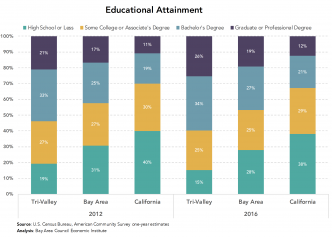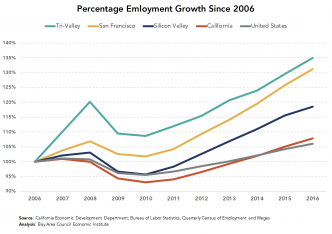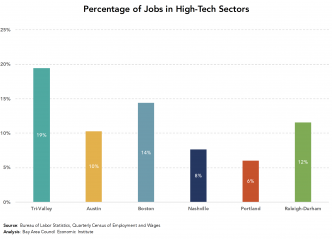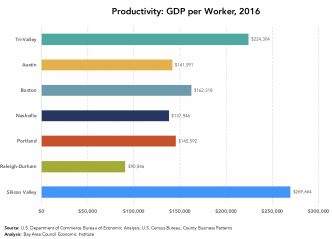
Tri-Valley Rising 2018
Tri-Valley Rising was published in 2014 with the aim of taking inventory of the Tri-Valley region’s assets and resources, explaining its impressive economic success, identifying challenges that could threaten to impede its future growth, and providing policy recommendations to ensure its continued vitality. This July 2018 update to Tri-Valley Rising builds on the findings and information presented in the first report, while also exploring more policy options for local and regional stakeholders to better connect and strengthen the Tri-Valley’s economy as it continues to grow.
Executive Summary
Since the publication of Tri-Valley Rising in 2014, the Tri-Valley region has only continued to grow. Given its high quality of life and proximity to top jobs, large numbers of people have continued to move to the Tri-Valley. The region has grown by 8% just since 2014, adding 28,000 more people. The number of jobs has grown even more rapidly, increasing by 12% since 2014.
This growth is due to a variety of assets that have made the Tri-Valley such a successful hub of economic activity. These key factors include:
• A highly educated population –– 60% of Tri-Valley residents have a bachelor’s degree or higher, making the region significantly more highly educated than California or the Bay Area as a whole. This strong talent pool makes the Tri-Valley a very attractive place for employers to locate.
• Geographic connectivity to one of the most economically productive regions in the world –– the Tri-Valley is at the heart of the Northern California Megaregion, close to San Francisco, Silicon Valley, Sacramento, and the Central Valley, which has allowed it to attract new and growing businesses, in addition to a large pool of workers.
• Comparative affordability of housing –– although Tri-Valley home prices have been rising quickly, they are still less expensive than in Silicon Valley and San Francisco. The median home value in the Tri-Valley is still below $1 million, while in San Francisco it is $1.2 million and in Silicon Valley it is $1.1 million.
• High-value, lower-cost commercial real estate –– for businesses looking to open offices in the region, locating in the Tri-Valley instead of San Francisco can mean saving more than half of what they would otherwise be paying for rent. It also often means getting high-value space in amenity-filled campuses like Bishop Ranch and Hacienda. The average price per square foot for office space is $32.04 in the Tri-Valley, compared to $52.20 in Silicon Valley and $74.17 in San Francisco.
• A high quality of life that attracts innovators and business leaders –– the Tri-Valley’s natural beauty, tight-knit communities, top-notch schools, and charming downtowns are often cited as key reasons behind the decision to do business in the Tri-Valley. The region’s schools are among the best in the state, with a graduation rate of 97%, compared to 86% for the Bay Area as a whole. The Tri-Valley also excels at offering opportunities for work-life balance, allowing people to live nearby to where they work.
• An ecosystem of innovation –– the Tri-Valley has become a hotbed of innovation and entrepreneurship. The two national laboratories––Lawrence Livermore National Laboratory and Sandia National Laboratory––have led the region in innovation for over 50 years. Incubators such as i-GATE and accelerators such as BRIIA have helped homegrown entrepreneurs succeed. Over 450 technology companies are located in the Tri-Valley, and the region has received over $4 billion in venture capital and private equity investment in the past 10 years.
While all of this growth has brought great economic success to the Tri-Valley, it has also brought with it some of the accompanying challenges that have been facing much of the rest of the Bay Area. We present several key findings and recommendations to ensure that the Tri-Valley retains its high quality of life while at the same time allowing innovation and economic expansion:
• Housing development is needed to stem the rise in cost of living. Although wages have generally kept better pace with increases in the cost of living in the Tri-Valley than in San Francisco, growth in cost of living has begun to outpace wages in recent years. High demand for housing in the Tri-Valley is reflected in rapidly rising home prices.
• If housing prices continue to rise, Tri-Valley businesses may have a hard time attracting workers. It will be imperative to increase the supply of housing to satisfy some of the high demand. The Tri-Valley has been more successful than Silicon Valley and San Francisco in creating a jobs-to-housing balance, but more housing is still needed. Transit-oriented development will be an important piece in achieving a better jobs-to-housing balance.
• Transportation is the key bottleneck for the Tri-Valley’s growth. The increasing cost of Bay Area housing has also contributed to another of the Tri-Valley’s major challenges: transportation. As people working in the Bay Area move to more far flung places around the megaregion, they must travel longer distances to get to their jobs.
• Average daily vehicle hours of delay on I-580 and I-680 have increased significantly since 2013, and greater strain has been placed on both BART and ACE as transit ridership rises. Investment in transportation will be key in maintaining the Tri-Valley’s status as a desirable place to live and work. Important steps will include creating greater megaregional transit connectivity in the form of a rail link between ACE and BART, as well as strengthening the core of the transit system.
Planning for the future of the Tri-Valley will require a great deal of collaboration. To this end, we recommend that Innovation Tri-Valley Leadership Group serve as the convener of the five cities, two counties, and other regional stakeholders to create an “Innovation Tri-Valley Vision Plan.” Through the process of creating this plan, stakeholders should seek to answer how they can ensure the sustainability of their economies while continuing to attract businesses and the jobs that they bring.
The plan should address the need for greater transit connectivity, improved transportation infrastructure, a larger supply of housing for a range of income groups, preparedness for future innovations in mobility and the nature of work, and enhanced support for entrepreneurship and innovation. Such a plan can create a roadmap for setting the Tri-Valley on a path toward an even brighter future.


